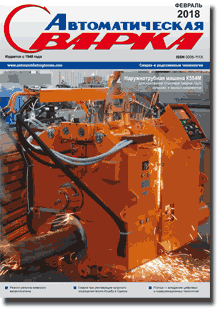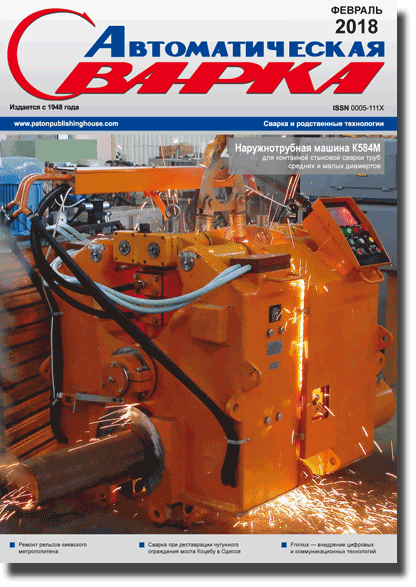| 2018 №02 (03) |
DOI of Article 10.15407/as2018.02.04 |
2018 №02 (05) |

Avtomaticheskaya Svarka (Automatic Welding), #2, 2018, pp. 25-29
Effect of structure of joint zone of diamond layer with hard-alloy substrate of brazed cutters on their service life
B.V. Stefaniv and O.M. Sabadash
E.O. Paton Electric Welding Institute of the NAS of Ukraine 11 Kazimir Malevich Str., 03150, Kyiv, Ukraine. E-mail: office@paton.kiev.ua
Abstract
Service life of the drilling bits with diamond-hard-alloy cutters (DHC) is determined by value of drifting under conditions of abrasive, erosion and corrosion wear in drilling of degassing holes. Evaluation of wear and microstructure of a joint of diamond layer with hard-alloy substrate of «Syndrill» integral cutter of «Element Six» company (Ireland) and complex cutter (ISM of NASU) of drilling bits after completion of their life was carried out in the work. It is shown that cobalt in the integral cutters is uniformly distributed in the diamond layer and its amount makes up to 2.06 wt.% in contrast to complex ones, where amount of cobalt is 4.35 wt.%. Increase of cobalt content and decrease of volume content of the diamond grains in diamond layer of the complex cutters reduce their heat and wear resistance. Porosity of complex diamond-hard-alloy cutters is 2 times more in comparison with integral «Syndrill» cutters that promote penetration of larger amount of brazing alloy elements (cooper and zinc) in a transition zone of joint of hard-alloy substrate and diamond layer. 7 Ref., 2 Tables, 6 Figures.
Keywords: drilling bit, diamond layer, diamond-hard-alloy cutter, diamond-hard-alloy plate, hard-alloy substrate, sintered material, brazing, brazing alloy, microstructure, porosity, wear
Received: 29.11.17
Published: 15.03.18
References
- Khorunov, V.F., Stefaniv, B.V., Sabadash, O.M. et al. (2012) Peculiarities of restoration technologies of drill bits with diamond-hard-alloy cutters. In: Problems of life and safety of service of structures, constructions and machines: Transact. of 2010–2012 results. Kyiv, PWI, 488–493 [in Russian].
- Stefaniv, B.V. (2013) Development of the technology of brazing of diamond-hard-alloy cutters. The Paton Welding J., 2, 37–41.
- Stefaniv, B.V. (2013) Peculiarities of induction brazing of diamond-hard- alloy cutters to blade of body of complex drill. Ibid., 8, 49–53.
- Stefaniv, B.V., Khorunov, V.F., Sabadash, O.M. et al. (2015) Peculiarities of restoration technology for worn working parts of steel and matrix bodies of drilling bits. In: Problems of life and safety of service of structures, constructions and machines: Transact. of 2013–2015 results. Kyiv, PWI, 688–696 [in Russian].
- Chintamaneni, V., Bellin, F. (2013) High-temperature treatment at high heating rate of pdc cutters. Pat. 2628593, RU, Int. Cl. C21D 9/22, E21B 10/567 [in Russian].
- Goncharenko, I.M. Physical basics of development and manufacture of hard alloys. http://portal.tru.ru
- Besson, A., Burr, B., Dillard, S. et al. (2000) On the cutting edge. Oilfield Review, 12(3), 36–57.
The cost of subscription/purchase order journals or individual articles
| Journal/Currency | Annual Set | 1 issue printed |
1 issue |
one article |
| TPWJ/USD | 384 $ | 32 $ | 26 $ | 13 $ |
| TPWJ/EUR | 348 € | 29 € | 24 € | 12 € |
| TPWJ/UAH | 7200 UAH | 600 UAH | 600 UAH | 280 UAH |
| AS/UAH | 1800 UAH | 300 UAH | 300 UAH | 150 UAH |
| AS/USD | 192 $ | 32 $ | 26 $ | 13 $ |
| AS/EUR | 180 € | 30 € | 25 € | 12 € |
| SEM/UAH | 1200 UAH | 300 UAH | 300 UAH | 150 UAH |
| SEM/USD | 128 $ | 32 $ | 26 $ | 13 $ |
| SEM/EUR | 120 € | 30 € | 25 € | 12 € |
| TDNK/UAH | 1200 UAH | 300 UAH | 300 UAH | 150 UAH |
| TDNK/USD | 128 $ | 32 $ | 26 $ | 13 $ |
| TDNK/EUR | 120 € | 30 € | 25 € | 15 € |
AS = «Automatic Welding» - 6 issues per year;
TPWJ = «PATON WELDING JOURNAL» - 12 issues per year;
SEM = «Electrometallurgy Today» - 4 issues per year;
TDNK = «Technical Diagnostics and Non-Destructive Testing» - 4 issues per year.





